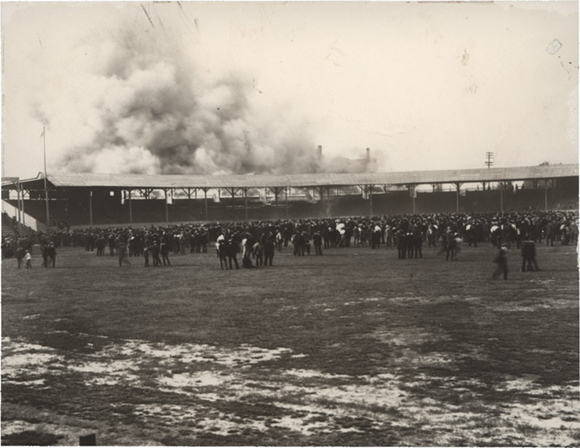
Ballpark fires are extreme rare these days, but at one time were a major threat to baseball operations. Jesse Goldberg-Strassler looks at how ballpark design changed because of fire awareness.
On January 3, a fire significantly damaged Fifth Third Ballpark, home of the Midwest League’s West Michigan Whitecaps. Thankfully, no one was injured.
Photographs of the ballpark reveal just how heavy the damage is, destroying the suite level and concourse down the first base and right field line. I work in the Midwest League, and I can attest to the quality of the West Michigan franchise, from ownership to the seasonal staff. Their heads are up in the face of adversity, preparing for their 20th Annual Winter Banquet on January 23, rebuilding the stadium for Opening Day on April 8 and the Midwest League All-Star Gameon June 17.
There was a time, over a century ago, when fires at ballparks were an all-too-regular occurrence.
Boston now boasts Fenway Park, but the pride of Beantown in 1894 was the South End Grounds, nicknamed the Grand Pavilion, a magnificent double-decker stadium at the corner of Columbus and Walpole in Roxbury. It was here where the Great Roxbury Fire began; innocently ignited by boys playing underneath the right field bleachers, it built in intensity during an on-field rhubarb between Baltimore’s John McGraw and Boston’s Tommy Tucker. In all, 117 other buildings burned along with the stadium.
St. Louis’s Sportsman’s Park had endured a fire two years earlier, in 1892, but carried on. In 1898, however, things took a turn for the dramatic. “Ball Players Heroically Snatch Spectators From The Seething Flames” blared The Sporting News. From the This Game of Games blog:
But the fire, which began as a nuisance, “gained in fury,” wrote The Sporting News. “As the heat from the burning structure increased in intensity, the people hastened their efforts to escape. Hundreds rushed up the exit from the grounds between the club and saloon only to find the gate closed.” These fans forced their way through the gate. Others were helped onto the playing surface by the St. Louis and Chicago players. One-hundred people were reported injured in all. As far as the series was concerned:
In the immediate aftermath of the fire, thought was given to transferring the remainder of the series to Chicago but the idea was rejected by Browns manager Tim Hurst. Instead, that night, “a gang of men were set to work…and the fences repaired and temporary stands erected …” Hurst and his players assisted the workers Saturday night “under electric lights” and enough was accomplished so that a game was played on Sunday as scheduled. Before a crowd of 7,000 people, the weary Browns lost to Chicago by a score of 14-1.
In the end, the fire not only damaged the stadium, it ended the ownership reign of larger-than-life promoter Chris Von Der Ahe.
Like Boston’s Grand Pavilion, the Philadelphia Base Ball Park was also destroyed in 1894 by a fire. The solution to rebuild the stadium led to mostly steel construction instead of wood. Fifteen years later, as Peter Morris notes in A Game of Inches, the Philadelphia Athletics’ new home of Shibe Park became the very first honest-to-goodness concrete-and-steel stadium. This became the norm.
Cincinnati owner John T. Brush took his own measures when it came to construction materials. When League Park‘s iron-and-wood grandstand burned in 1900, and then again in 1901, he spent his money erecting a new grandstand of steel-and-stone. The result was the fabulous Palace of the Fans — which fell into disrepair, was also damaged by fire, and lasted only from 1902-1911 before getting replaced by Crosley Field. It was similarly in 1911 that American League Park, home of the Washington Senators, went up in a blaze caused by a plumber’s blowtorch. A year earlier at the ballpark, President Taft had set the tradition of U.S. presidents throwing out the first pitch on Opening Day.
The introduction of Crosley Field, Shibe Park, Washington’s Griffith Stadium, and others — Boston’s Fenway Park and Chicago’s Wrigley Field (originally Weeghman Park) among them — ushered baseball into a new era, where stadium did not last on a mere year-to-year basis, but could now be counted upon to host the national pastime for decade upon decade.
We are thankfully well beyond the hazards of early baseball. We do not fear the possibility of a fire when we attend a baseball game, nor do we do not merely shake our heads sadly and turn away upon hearing of a ballpark fire. This was a terrible occurrence in Comstock Park, Michigan, an occurrence that we hope no other stadium should have to deal with for a good long time, and we support the West Michigan Whitecaps to the fullest in rebuilding Fifth Third Ballpark.
Jesse Goldberg-Strassler is the voice of the Lansing Lugnuts and the author of The Baseball Thesaurus from August Publications.
Photo: St. Louis’s Sportsman’s Park was known as Robison Field in May 1901, when this fire occurred.
—-
This article originally appeared in the weekly Ballpark Digest newsletter. Are you a subscriber? You can sign up for a free subscription at the Newsletter Signup Page.
Share your news with the baseball community. Send it to us at editors@augustpublications.com.
Join Ballpark Digest on Facebook and on Twitter!
Follow Ballpark Digest on Google + and add us to your circles!
